How to Review a Grant Proposal in 4 Essential Steps
Learn how grantmakers can improve the grant review process with these key principles and specific tactics.

Last Updated May 21, 2025
4 key strategies for fair and effective grant review
The review process for grant proposals is where funders and organizations get to execute on their stated values. But selecting which grants to fund to pursue mission-driven outcomes is a big task—and it starts with understanding how to review a grant proposal effectively and efficiently.
With so many important and worthy causes or works out there, the process can be difficult emotionally, but it doesn’t have to be challenging operationally. From individual reviewers and program officers to directors and board members, reviewing grants can and should be streamlined so that impact can be maximized and hassle can be minimized.
Lucky for us, our team has seen thousands of grantmakers and individual grant reviewers tackle grant review through our grant management software. Here’s a look at how they manage it and how you can too.
Note: While we believe these efforts are best led from the organizational level in order to create consistency, if you’re an individual reviewer without clear direction, you can use these tips to create your own personal reviewing framework.
4 steps for reviewing grant proposals
1. Set principles for how you review grant proposals.
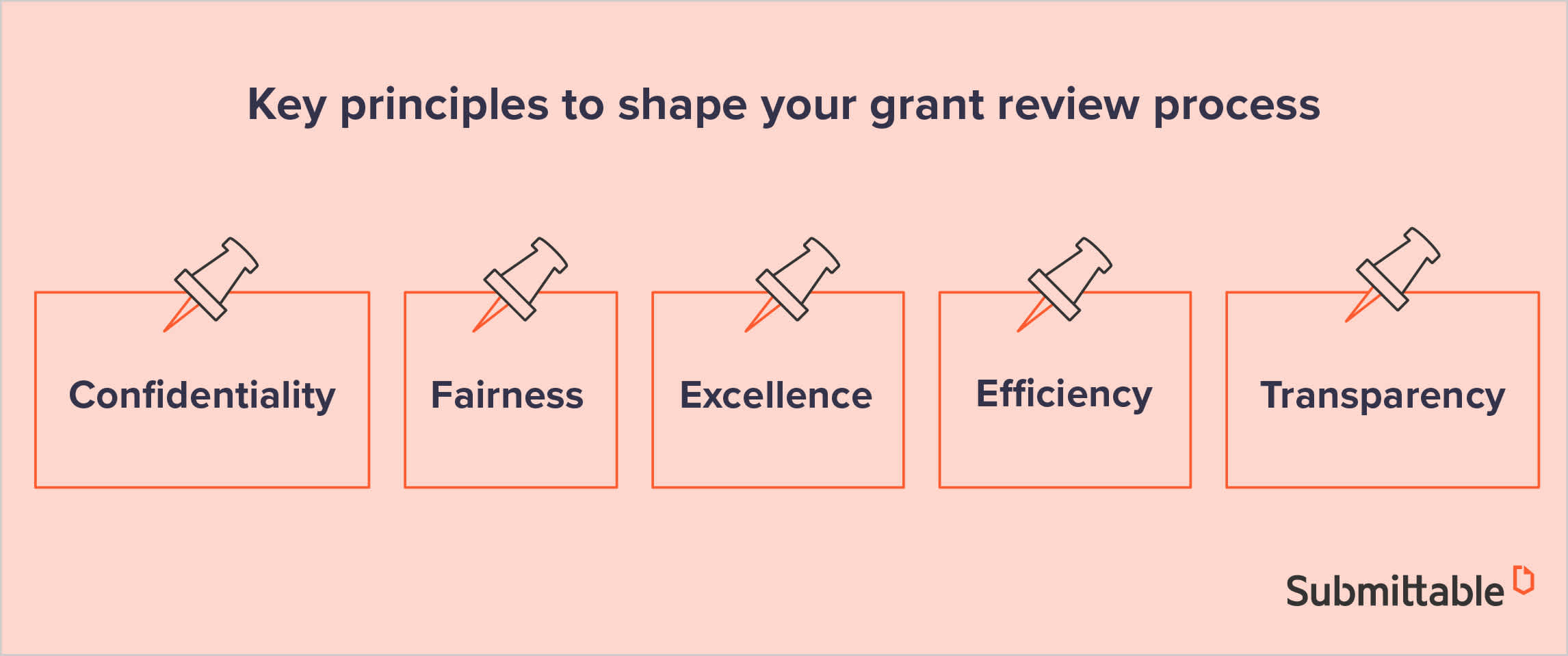
At the highest level, you’ll want your grant review process to be guided by a few key principles, grounded in what produces the best application and review experiences for all parties.
Ideally, these are set at the organizational level before individual grant reviewers begin evaluating applications.
But in cases where there isn’t organizational guidance, individual reviewers can also consider the principles they want to bring to their task.
Here are a few guideposts we consistently see used as resources:
Confidentiality. Keep grant-seekers’ private information on a need-to-know basis within one centralized grant management platform that you can easily control. To minimize the risk of implicit bias or favoritism, pinpoint which elements are absolutely essential for reviewers to make their decision—and which aren’t.
Fairness. Set up a grant review process that is as free of bias as possible, allowing reviewers to score applicants fairly and based on their relevant merits and suitability to the program.
Excellence. Grant-seekers and grantmakers both want projects that demonstrate a high level of quality. Having rigorous reporting metrics for the grant itself at the outset also helps set expectations for grantees and communicates that follow-through is expected in terms of the grant objectives.
Efficiency. When grant proposals are evaluated fully and grants awarded and administered as swiftly as possible, more energy and focus can be put towards the work that really matters.
Transparency. All funding decisions should be based on clearly defined rules that are communicated to grant-seekers and team members before any grant applications are reviewed.

Communicate these principles along with your application guidelines up front as a resource to applicants. Clarity around expectations and review criteria can help you receive more relevant applications and reduce questions, saving your review team time.
Here’s an example of how the principles above could be added to an organization’s main portal in Submittable:
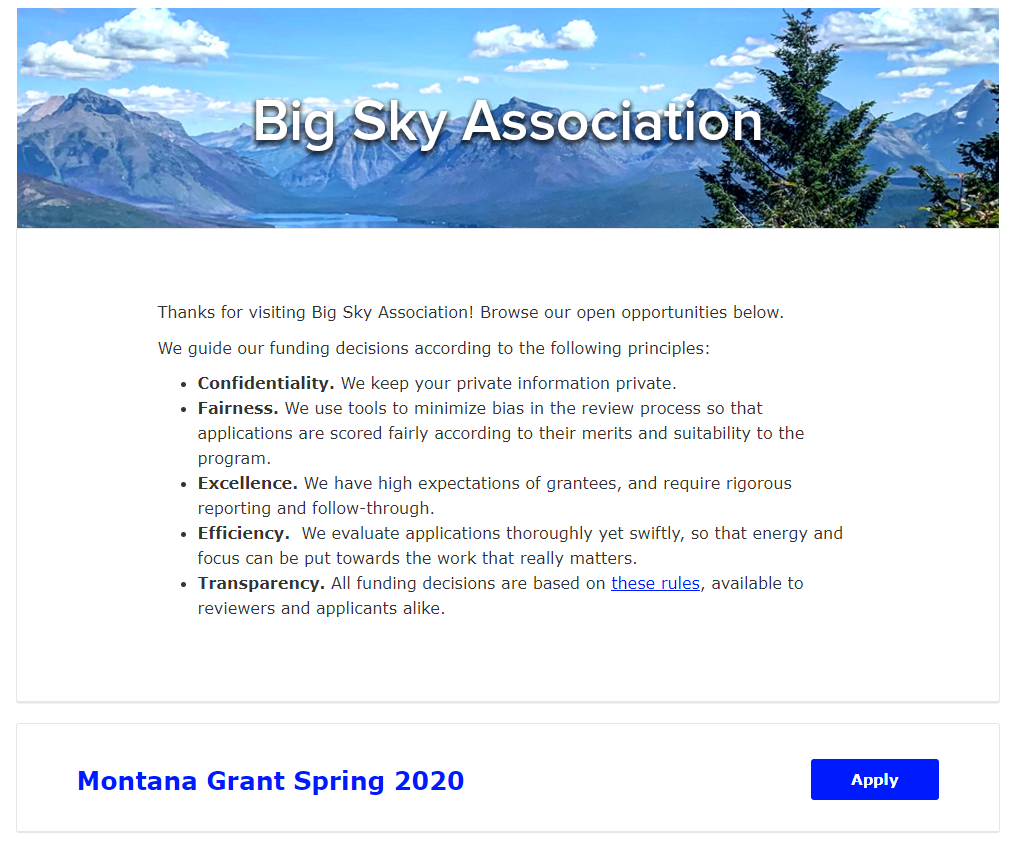
Organizations use Submittable’s guidelines feature to communicate their core principles and directions to applicants. This reduces applicant questions and creates confidence and clarity around your process.
2. Build a detailed review rubric to evaluate grants.
The first step to effectively critiquing a grant proposal is the creation of a thorough rubric. Rubrics are detailed outlines for how each application will be read and scored. A comprehensive rubric helps reviewers stay consistent, minimizes personal bias, and provides a useful resource to answer questions.
If you create a rubric before building your application, it can also help ensure all requested information in your application is relevant and necessary. This saves time for applicants as well as your team.
According to research from the Brown University’s Harriet W. Sheridan Center for Teaching and Learning, there are a series of vital steps to creating a successful rubric. Here are a few of the steps they identified, refocused for grant review:
Define the rubric’s purpose
Consider the components of your application and how each should be assessed. What would an outstanding application include? How detailed do you want to be with scoring? Should each application component receive a distinct score?
Choose between a holistic and analytical rubric
In terms of basic distinctions, the holistic rubric is easier to put together but offers less detail than an analytic rubric regarding specific strengths and weaknesses within an application.
For example, a holistic rubric might ask reviewers to assign a score of 1-5 for the application as a whole (where a Level 5 application includes excellent references, a strong evidence-based rationale for the project, and how project goals and objectives will be achieved and assessed is clearly defined).
An analytic rubric would assess references, rationale, and goals and objectives using distinct scales and criteria.
Define the review criteria
These criteria identify each component for assessment.
First, design a rating scale. For grant applications, numeric scores are most likely to be useful. Most scales include three to five rating levels.
Then, write descriptions for each rating. Focus on observations that can be accurately measured and include the degree to which criteria are successfully met.
Clarity and consistency of language here will help accurately guide reviewers as they reach each grant proposal.
Finalize the rubric
Once you have your rubric and review criteria defined, add them to your grants management software so that the same rubric is automatically applied to every application for every reviewer.
With Submittable’s grant management software, this step can take just minutes. A drag-and-drop form builder—the same type you use in the platform to build your application—makes it easy to create a custom form that gathers the qualitative and quantitative feedback you want.
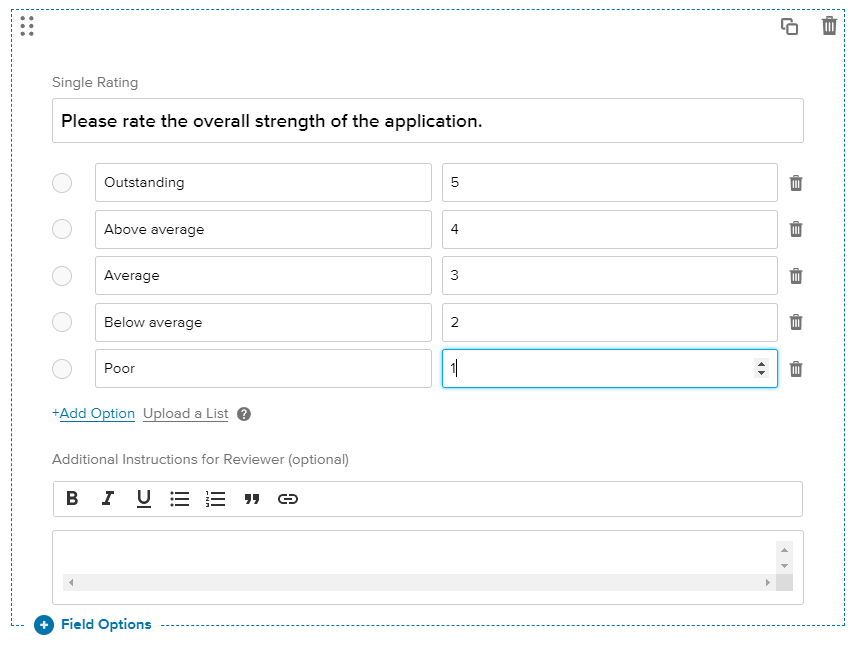
Set up custom review criteria and scoring with Submittable’s easy-to-use review tools.
Once your rubric is added, all your grant reviewers can see application materials in one place, side-by-side with the rubric criteria within the Submittable platform, and enter scores and feedback as they go. No more toggling between tabs, drowning in email, or time-consuming downloads.
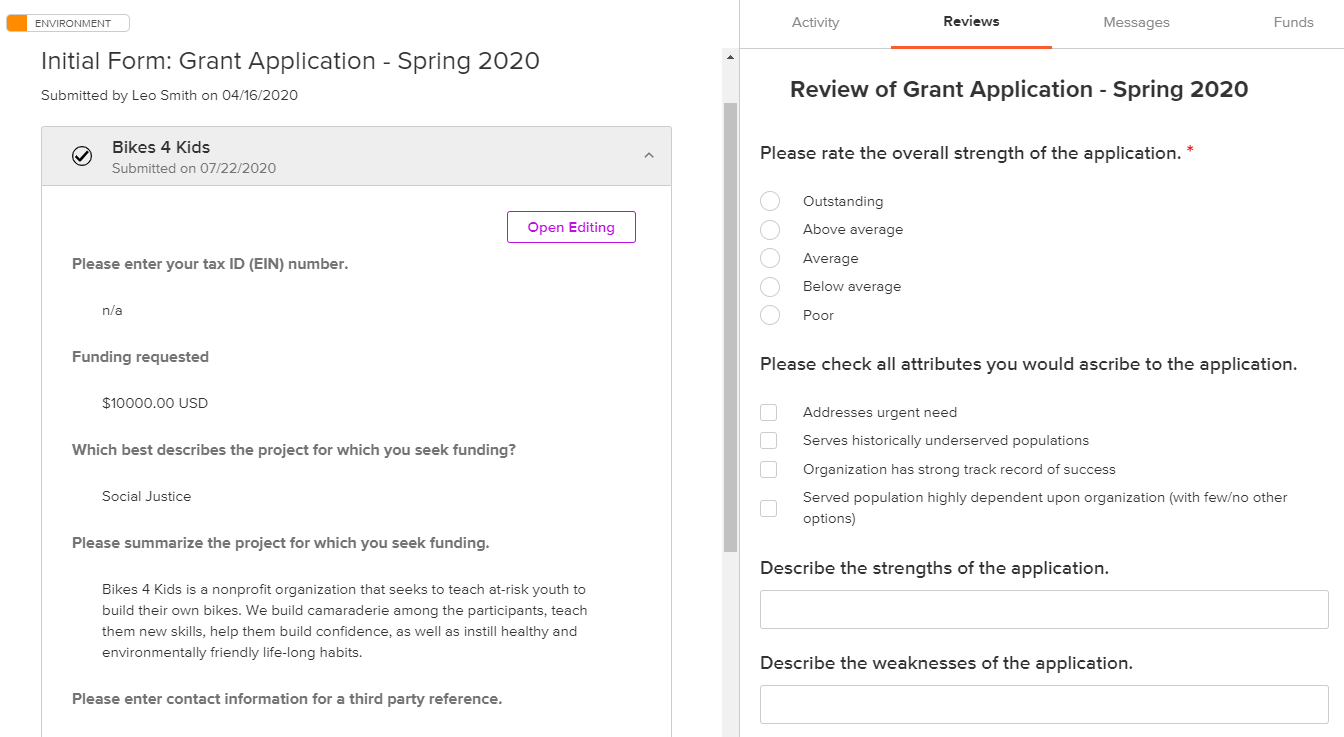
Having review rubrics and criteria side-to-side with applications in the Submittable platform keeps reviewers more focused and consistent as they review grant proposals.
Check out this short video for a quick step-by-step walk-through of how to set up a review process in Submittable:
A couple of additional rubric strategies to employ:
Assess your rubric carefully for language that could be misinterpreted. It’s important to avoid assumptions about reviewers, especially regarding how they will process the criteria, rating scale, and descriptions you provide.
Steer clear of industry jargon or acronyms. Use plain language and where possible give examples to solidify what you want to say and avoid questions.
Determine the relative weight of review criteria. For example, will letters of recommendation be more or less important than a clear evaluation framework? Design your rating scale accordingly.
3. Make good assignments.
By making clear your foundational principles and defining a clear rubric to judge applications, you’ve laid the groundwork for your reviewers to begin their work. Now is the point where you need to make sure your team executes that plan in a consistent and coordinated manner.
Spread out the work
A review team, as opposed to a single reviewer or two, will ensure a more fair assessment for every applicant.
If you’re offering a single grant, have two or three readers on each application. If you’re running several, you could group reviewers into teams, group applications by category, or rotate reviewers and applications throughout the process.
Reviewing across days, as opposed to completing all reviews in a single, long session, is more likely to yield a greater uniformity (and fairness) in your results. Encourage reviewers to divide and conquer over time by assigning in batches or rounds, or by establishing multiple deadlines and check-in points along the way.
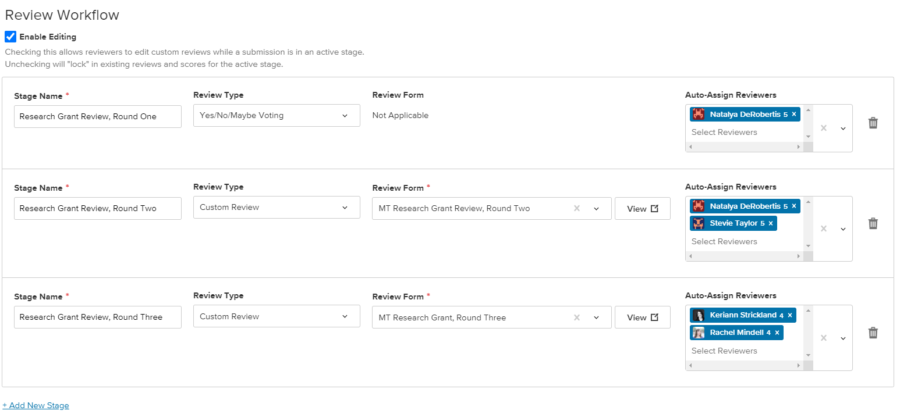
Easily set up a multi-stage process in Submittable. Each stage can be auto-assigned to the right team members and incorporate the style of review required at that point in your grant process.
Help reviewers write better grant critiques
Sharing your review process and criteria with applicants demonstrates that you care about diligent and fair review. It also demonstrates that you understand the value this information holds for applicants and you’re prepared to support them.
But how do you write a good grant critique? Lean on the rubric. The more detailed, thorough, and consistent your rubric is, the more useful it becomes when providing feedback.
This also keeps feedback consistent across reviewers and applications, and makes it easier for you to compare results when making your final choice.
Just be sure grant reviews are easy to share and written in a simple, jargon-free format.
4. Use a numerical strategy to find a winner.
There are two main approaches to capturing which applications are top contenders.
One strategy for scoring applications fairly is through a point system defined by your rubric. This type of averaging system is typically used for standards-based processes, which makes it extremely useful for scoring grant applications.
Calculate an average by adding all scores together and dividing by how many times the application was read. This ensures that each reviewer’s assessment has an equal weight.
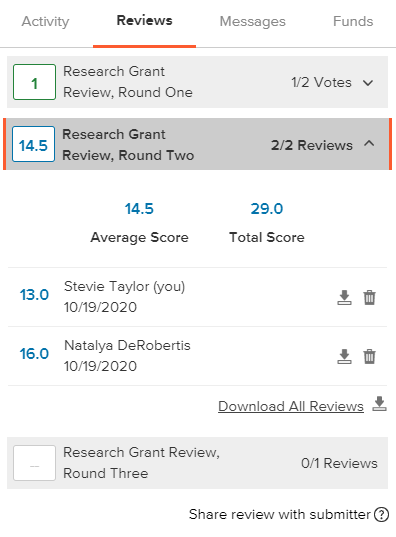
Submittable’s grant management platform shows you individual reviewer, average, and total scores.
A ranking system can be another great collaborative way to select grant winners. Using this strategy, reviewers are assigned a set number of applications to read and rank in quality order. Let’s say a reviewer is reviewing five applications—the best one would score a 1, the next best a 2, and so on, with the least favorite receiving a 5.
Then, each set of applications is passed on between other reviewers, who will also rank in order of quality. If reviewers are tasked with a high volume of applications, this method can help alleviate the pressure.
To find the strongest applications, add up the scores among all applications—the ones with the highest scores are ranked highest collectively.
Want to improve your grant review process?
With Submittable’s grant management software, you can review grant proposals more efficiently, with less bias.
Watch our short demo to learn more.
Go forth, and review
Launching a grant program based on a review process that’s fair, rigorous, and efficient relies on intentional planning, research, and thoughtful execution.
Just as your programs are unique, a review process that’s both fair and rigorous will look a bit different in every institution. The most important areas to focus on are a strong rubric, transparency, inclusivity, a balanced, numbers-based process, and the evasion of bias.
At their core, grants serve a primary mission—to fund worthy ideas and projects. A modern grants management software like Submittable can make it that much easier to establish or fine-tune your outstanding application and review process, so that both your applicants and your review team appreciate the results.

Keriann Strickland is the Chief Marketing Officer at Submittable where she leads its marketing and sales development teams. Happiest near mountains, she works from our Missoula, Montana office and has been with the company since 2018.






